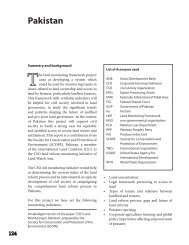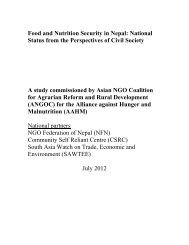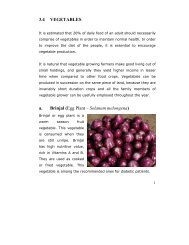Traditional Practices in Agriculture FULL - ANGOC Site
Traditional Practices in Agriculture FULL - ANGOC Site
Traditional Practices in Agriculture FULL - ANGOC Site
Create successful ePaper yourself
Turn your PDF publications into a flip-book with our unique Google optimized e-Paper software.
e. Acidlime (Citrus aurantifolia)<br />
This is also called as<br />
Kaghzi lime known for<br />
its soury juice <strong>in</strong>side<br />
the fruit, which has<br />
fetched this species a<br />
higher place than the<br />
lemons. They are rich <strong>in</strong><br />
Vitam<strong>in</strong> C and the rural<br />
folk mostly use them<br />
for pickles and <strong>in</strong> cook<strong>in</strong>g especially the ‘Gojju’ that makes a very<br />
good comb<strong>in</strong>ation with rice.<br />
1. Pits are dug and allowed to dry for 3 to 4 months.<br />
2. Burry<strong>in</strong>g the dog’s carcass at the root zone helps <strong>in</strong> gett<strong>in</strong>g<br />
higher yields <strong>in</strong> acid lime.<br />
3. Apply<strong>in</strong>g 10 kg of pig manure per tree, helps to <strong>in</strong>crease the<br />
yield and to prevent flower shedd<strong>in</strong>g.<br />
4. Four kg of Neem seeds are powdered and dissolved <strong>in</strong> 100<br />
litres of water and filtered. Add 10 lit of cow ur<strong>in</strong>e and mix it<br />
with 50 gm of detergent powder. Spray<strong>in</strong>g this extract will<br />
control leaf m<strong>in</strong>er pest and other diseases.<br />
5. Dried neem fruits are powdered and applied at 500 gm per<br />
tree to control the nematode attack.<br />
6. To control sooty mould, maida flour( 500 gm <strong>in</strong> 5 lit of water)<br />
is boiled <strong>in</strong> water to colloidal stage and it is diluted, filtered<br />
8
















